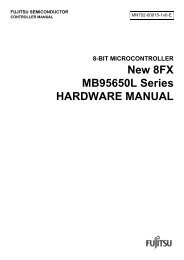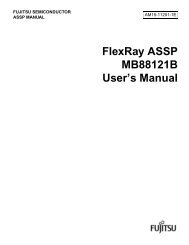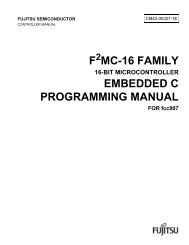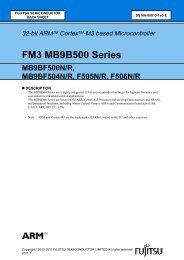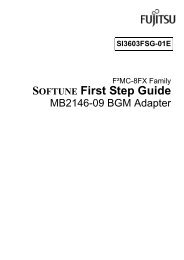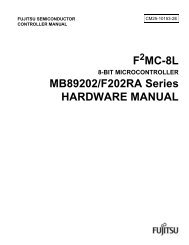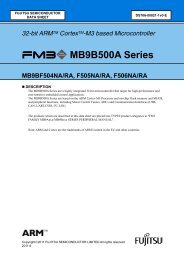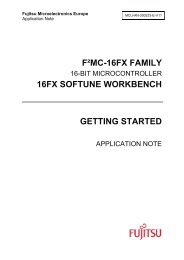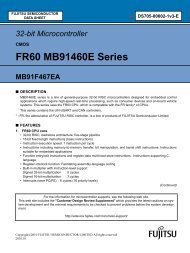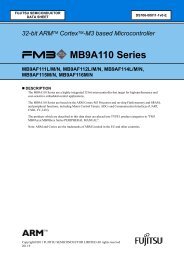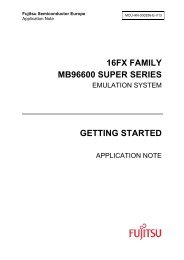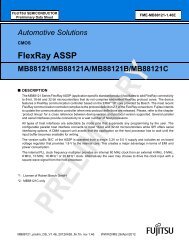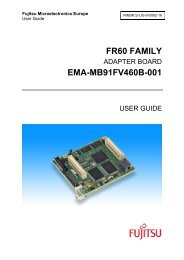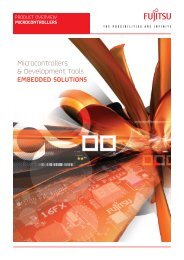J-Link / J-Trace User Guide (UM08001) - Microcontrollers
J-Link / J-Trace User Guide (UM08001) - Microcontrollers
J-Link / J-Trace User Guide (UM08001) - Microcontrollers
Create successful ePaper yourself
Turn your PDF publications into a flip-book with our unique Google optimized e-Paper software.
200 CHAPTER 10 Designing the target board for trace<br />
10.1 Overview of high-speed board design<br />
Failure to observe high-speed design rules when designing a target system containing<br />
an ARM Embedded <strong>Trace</strong> Macrocell (ETM) trace port can result in incorrect data<br />
being captured by J-<strong>Trace</strong>.You must give serious consideration to high-speed signals<br />
when designing the target system.<br />
The signals coming from an ARM ETM trace port can have very fast rise and fall<br />
times, even at relatively low frequencies.<br />
Note: These principles apply to all of the trace port signals (TRACEPKT[0:15],<br />
PIPESTAT[0:2], TRACESYNC), but special care must be taken with TRACECLK.<br />
10.1.1 Avoiding stubs<br />
Stubs are short pieces of track that tee off from the main track carrying the signal to,<br />
for example, a test point or a connection to an intermediate device. Stubs cause<br />
impedance discontinuities that affect signal quality and must be avoided.<br />
Special care must therefore be taken when ETM signals are multiplexed with other<br />
pin functions and where the PCB is designed to support both functions with differing<br />
tracking requirements.<br />
10.1.2 Minimizing Signal Skew (Balancing PCB Track Lengths)<br />
You must attempt to match the lengths of the PCB tracks carrying all of TRACECLK,<br />
PIPESTAT, TRACESYNC, and TRACEPKT from the ASIC to the mictor connector to<br />
within approximately 0.5 inches (12.5mm) of each other. Any greater differences<br />
directly impact the setup and hold time requirements.<br />
10.1.3 Minimizing Crosstalk<br />
Normal high-speed design rules must be observed. For example, do not run dynamic<br />
signals parallel to each other for any significant distance, keep them spaced well<br />
apart, and use a ground plane and so forth. Particular attention must be paid to the<br />
TRACECLK signal. If in any doubt, place grounds or static signals between the<br />
TRACECLK and any other dynamic signals.<br />
10.1.4 Using impedance matching and termination<br />
Termination is almost certainly necessary, but there are some circumstances where it<br />
is not required. The decision is related to track length between the ASIC and the<br />
JTAG+<strong>Trace</strong> connector, see Terminating the trace signal on page 201 for further reference.<br />
J-<strong>Link</strong> / J-<strong>Trace</strong> (<strong>UM08001</strong>) © 2004-2010 SEGGER Microcontroller GmbH & Co. KG



